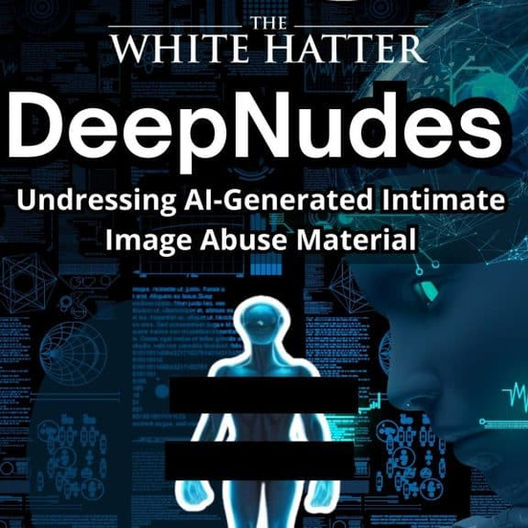Battling AI-Driven Deepfake Nudes Demands Swift Action, Collaboration, & A Change In The Selfie Culture in Canada
- The White Hatter

- Jan 10, 2024
- 5 min read
Updated: May 7, 2025

Since the publication of our initial article (1) highlighting the disturbing trend of individuals, both youth and adults, utilizing AI to create deep fake nude images for malicious purposes such as online harassment and extortion, the proliferation of such AI software has surged, with no signs of slowing down (2).
In Canada, we do have “some” legal frameworks at both federal and provincial levels, such as the "Intimate Image Protection Act" in British Columbia, which can be invoked to hold perpetrators legally accountable for the creation and weaponization of deep fake nude technology. Now, do federal laws need to the tightened up specific to weaponized AI Nudes – ABSOLUTELY! We believe there should be a law that makes the possession of such specifically designed technology illegal – we already do this in Canada with other technology such as cellphone jammers. However, these laws, while crucial, remain reactive in nature and provide limited support in addressing the profound emotional, psychological, and social repercussions experienced by survivors of these types of crimes when these types of manipulated images are disseminated publicly.
Given the above, we wanted to pose a question, “Given the exigent circumstances of this threat, what proactive steps can be taken to help minimize the associated risks?” Let’s delve deeper and consider some answers.
#1: Education
Educational initiatives must play a pivotal role, focusing on raising awareness about the threat posed by deep fake nude technology and highlighting the ethical and legal considerations surrounding consent in the generation of AI-altered images. We have now had two cases here in Canada, there will be more, where this type of technology was used by high school students to target others at their school. Education on this topic should be seamlessly integrated into existing digital literacy education programs, something that we have done here at the White Hatter for the past 12 months.
#2: Technology
Technological countermeasures, such as the rapid development and implementation of AI detection technologies or cloaking technology like Glaze (3), are imperative. efforts to strengthen legislation that unequivocally criminalizes the creation, possession, and distribution of such malicious content are essential. However, these endeavors require time, a resource that, unfortunately, is not on our side given the increasing frequency of these types of AI apps coming to market. Collaboration between tech industry stakeholders, government bodies, and advocacy groups is essential in expediting the development and implementation of robust solutions. Collaboration between tech industry stakeholders, government bodies, and advocacy groups is essential in expediting the development and implementation of robust solutions. By fostering a united front against the misuse of AI technology, we can collectively address the challenges posed by deep fake nude images and their detrimental impact on individuals and society as a whole.
#3: Vendor Accountability
Social media platforms, Internet Service Providers (ISPs), and online communities have a pivotal role to play in combating the dissemination of deep fake content. Stricter content moderation policies, enhanced reporting mechanisms, and the integration of advanced AI algorithms for detection are all measures that can be employed to identify and remove malicious content promptly. Unfortunately, past performance dictates future behaviour - social media platforms and internet service providers are slow to act on most issues surrounding online safety, thus why government needs to step up and legislate such action.
However, while awaiting comprehensive legal and technological measures, it is incumbent upon youth and adults to also exercise caution and mindfulness in their online activities. This includes critically evaluating privacy settings, being discerning about pictures shared that we will discuss next, and promptly reporting any instances of deep fake harassment to the police.
So, What Can Be Done Now To Reduce The Risk?
Truly, as AI technology advances, ensuring a picture won't be utilized to generate AI-created explicit content is increasingly challenging. The most foolproof solution is to refrain from posting any pictures at all. Yet, is this practical in today's digitally connected world? And what about photos taken without your consent and shared online by others?
Presently, the only way to reduce the risk, other than not posting a picture, is a proactive approach to curbing the types of images we share online, especially re-evaluating the nature of "selfies". It is crucial to adopt a conscientious approach to online self-presentation to minimize vulnerability in the face of evolving AI deepfake nude technological threats.
When sharing images of yourself on the internet, explore the use of increasingly accessible "watermarking" applications that "might" offer additional protection. (4) Another alternative involves altering the profile angle of selfies or pictures. Rather than opting for a straightforward front-facing image, consider angling the head and body, making it more challenging for AI to manipulate screen-scraped pictures. Additionally, reconsider posting images where individuals are clad only in swimwear or underwear, as these types of pictures are more susceptible to being manipulated and “nudified”.
Ultimately, a multifaceted approach is needed to effectively tackle the challenges posed by AI-generated deep fake nudes. Education, technology, legislation, and individual responsibility must converge to create a resilient defense against this emerging threat, ensuring a safer and more secure digital landscape for everyone. Only through a concerted and collaborative effort can we hope to stay ahead of those seeking to exploit these technologies for nefarious purposes.
Fostering empathy and digital citizenship is integral to building a more compassionate online environment. Initiatives that encourage empathy education can help individuals understand the human impact of their actions online and discourage the creation and dissemination of harmful content such as Ai generated nudes.
Addressing the root causes of this issue involves delving into societal norms and attitudes surrounding privacy and consent. Open dialogues within families, schools, and communities can contribute to a collective understanding of the importance of respecting one another's digital boundaries and privacy.
The escalating prevalence of AI-generated deep fake nude images demands urgent attention and comprehensive action. The existing legal frameworks in Canada, while a step in the right direction, require substantial reinforcement to effectively combat the weaponization of AI technology.
Proactive measures are imperative as a counter measure to this threat, and our proposed strategies encompass education, technology, accountability, and individual responsibility can help to minimize this threat. Collaborative efforts involving government bodies, tech industry stakeholders, and advocacy groups are essential to expedite the development and implementation of robust solutions. It is crucial to prioritize educational initiatives, technological countermeasures, and stricter accountability mechanisms. Additionally, fostering consent, empathy, and digital citizenship can contribute to a safer online environment.
As we navigate the evolving landscape of AI generated nudes, a multifaceted approach is paramount to address the root causes and build a resilient defense against the misuse of AI technology. By collectively striving for a safer onlife world, we can help mitigate the risks associated with deep fake nude images and protect individuals and society as a whole.
Regrettably, even if the precautions outlined in this article are implemented, there will always be individuals who use this technology to target others. It is crucial for our legal system to actively pursue and address such individuals using all available resources at their disposal.
Digital Food For Thought
The White Hatter
References:














